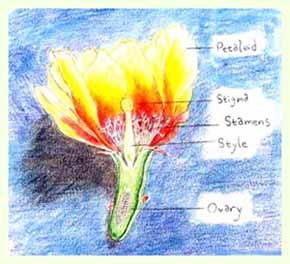
Strictly speaking, a page describing flowers should include all of the Angiosperms, or "boxed seed" plants, meaning those plants whose seeds are enclosed in specialized ovaries (as opposed to the Gymnosperms, "naked seed" plants whose seeds lack ovaries). Angiosperms produce flowers that generate stamens and pistils. Economically speaking, the Angiosperms are the world's most important plants.
Most of the wildflowers on these pages however will concentrate on a subset of the Angiosperms: the so-called "Wildflowers"—annual plants whose main above-ground growth dies at the end of the growing season and which generally lack woody stems. This means that most "shrubs" and "trees"—from cacti and nolinas to acacias, mesquites, paloverdes et al—are not included (except for the Flowering Schedules page, which is a fairly comprehensive listing). For more details on the flowerings of yuccas, cacti, our more substantial trees and shrubs, etc., see the other headings under the "Flora" section of Our Lands and Their Creatures. (We do however at present include some of the smaller perennial shrubs on the wildflower pages, just for the sake of rugged inconsistency and the beauty their sightings do afford. Eventually we will move them over to a separate, linked page on small flowering shrubs.)
The links on the side provide detailed information on wildflowers and other Saguaro Juniper related information. Wildflowers on Saguaro Juniper Lands presents images of flowering annuals (and a few perennials) that we have identified on our lands. Also included are images from the 2001 Wildflower Walk—an organized walk done in a year of exceptional wildflowering; flowering schedules from the William G. McGinnies list for the Sonoran desert, which was compiled between 1966 and 1985, and information regarding the unique seasonal changes in our area.
Datura Meteloides are a flowering plant in our area that deserve special concern and consideration. Click here for more information on this unique flower.

